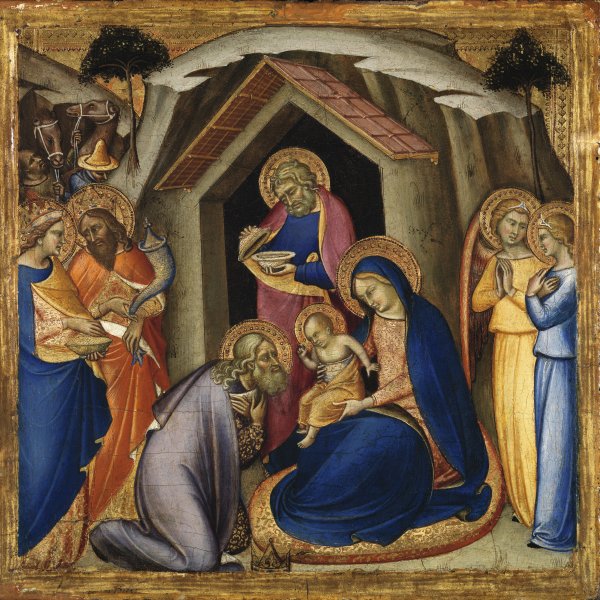The Coronation of the Virgin with five Angels
1355
Tempera and gold on panel.
86 x 52.5 cm
Museo Nacional Thyssen-Bornemisza, Madrid
Inv. no.
247
(1930.106
)
ROOM 1
Level 2
Permanent Collection
This panel depicting The Coronation of the Virgin remained unpublished until its inclusion in the 1930 Munich exhibition of paintings from the Collection, appearing in the catalogue as a work by Jacopo di Cione, an attribution made by Raimond van Marle. The catalogue also reproduced the opinion of Wilhelm Suida, who was inclined to attribute this panel to the Venetian painter Nicolò Semitecolo. This attribution was retained in the Thyssen- Bornemisza collection’s publications until 1989, when Caroline de Watteville catalogued it as a work by an anonymous master. In a letter sent to Villa Favorita, Federico Zeri expressed his disagreement with Suida’s suggestion, noting that he could not detect any features in the painting comparable to those seen in works by Semitecolo executed in Padua or Venice. Zeri focused on the inscription on the lower step of the throne, in which he read the name of Montezago, a small village belonging to Lugagnano Val d’Arda near Piacenza and from which the patron of this work, Pietro da Montezago, undoubtedly took his name. In 1978Mauro Natale stated that the work originated in Piacenza and related this panel to two others: one in a private Paris collection and another in a Montecarlo gallery. Some years later in 1986, Lucco stated that for reasons of style and composition the panel could not be considered Venetian.
The present attribution of the panel was made by Boskovitswho discerned a new hand to whom he gave the name Master of 1355 after the date on the step, and whose style he considered to be influenced by the workshop of Jacopino and Bartolommeo da Reggio. Among the works that Boskovits attributed to this new artist are a fresco of Saint George and the Princess in Fidenza cathedral, and fragments of a mural painting with a Crucifixion in the church of San Francesco in Piacenza.
The Coronation of the Virgin was the central element in a triptych, of which various lateral scenes have also been identified. For the left wing Boskovits proposed a Saint Louis of Toulouse, Saint John the Baptist and a Donor Monk. This donor monk has been tentatively identified as Pietro da Montezago. For the right wing, Boskovits suggested a panel with a scene from the life of Saint Anthony of Padua, a work in a private Paris collection. Above it would be the figure of Saint Paul in the Vittorio Cini collection in Venice.
The present panel reveals the use of a delicate brushstroke, evident on the faces, which are constructed from soft lines, and on the long, slender arms and the hands with their elegant fingers. These characteristics are also evident in the three musical angels behind the throne, who look down over the piece of brocade that acts as the backdrop, holding a stringed instrument, a portable organ and a psaltery respectively.
Mar Borobia
The present attribution of the panel was made by Boskovitswho discerned a new hand to whom he gave the name Master of 1355 after the date on the step, and whose style he considered to be influenced by the workshop of Jacopino and Bartolommeo da Reggio. Among the works that Boskovits attributed to this new artist are a fresco of Saint George and the Princess in Fidenza cathedral, and fragments of a mural painting with a Crucifixion in the church of San Francesco in Piacenza.
The Coronation of the Virgin was the central element in a triptych, of which various lateral scenes have also been identified. For the left wing Boskovits proposed a Saint Louis of Toulouse, Saint John the Baptist and a Donor Monk. This donor monk has been tentatively identified as Pietro da Montezago. For the right wing, Boskovits suggested a panel with a scene from the life of Saint Anthony of Padua, a work in a private Paris collection. Above it would be the figure of Saint Paul in the Vittorio Cini collection in Venice.
The present panel reveals the use of a delicate brushstroke, evident on the faces, which are constructed from soft lines, and on the long, slender arms and the hands with their elegant fingers. These characteristics are also evident in the three musical angels behind the throne, who look down over the piece of brocade that acts as the backdrop, holding a stringed instrument, a portable organ and a psaltery respectively.
Mar Borobia









